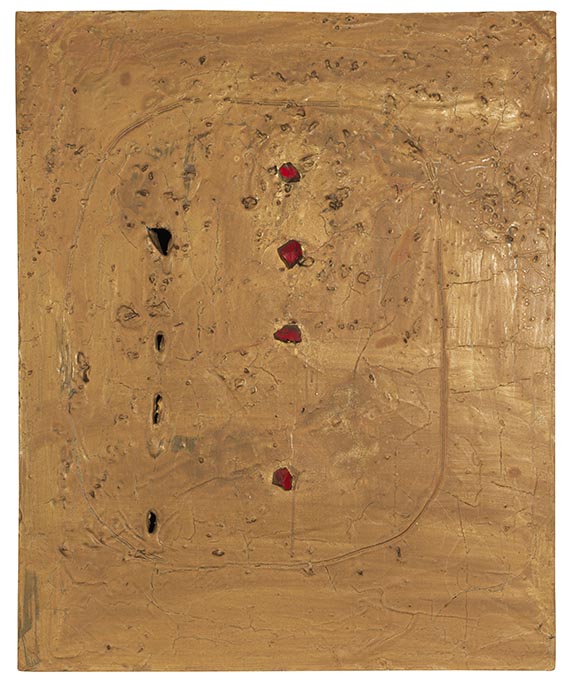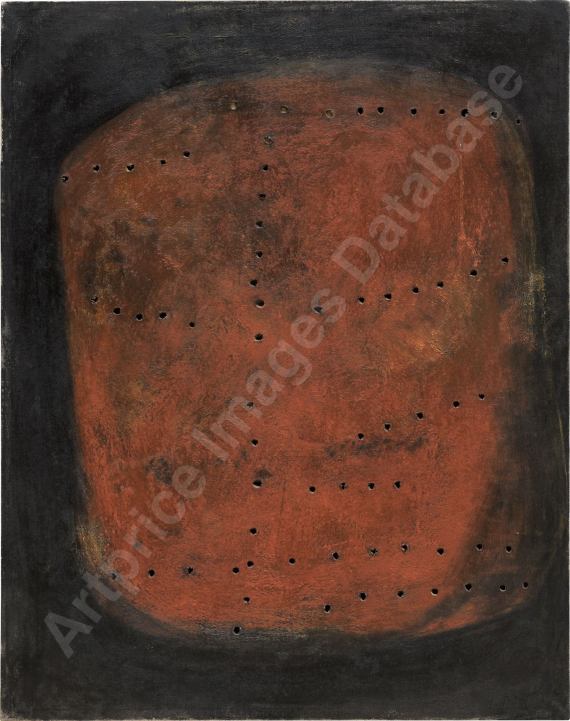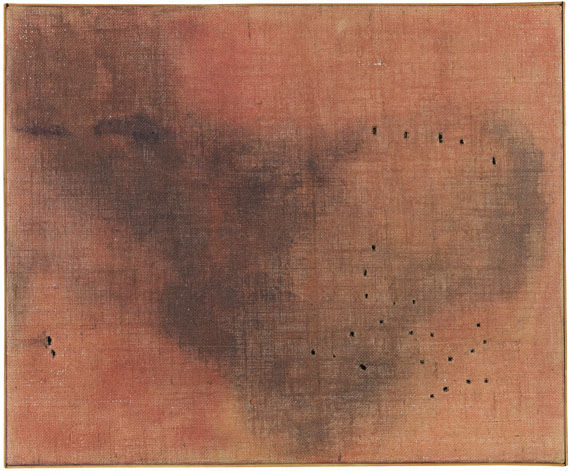124000133
Lucio Fontana
Concetto spaziale, 1957.
Oil and glass on canvas
Stima: € 180,000 / $ 192,600
Le informationi sulla commissione, le tasse e il diritto di seguito saranno disponibili quattro settimane prima dell´asta.
Concetto spaziale. 1957/61.
Oil and glass on canvas.
Signed, dated and titled on the reverse. 72.5 x 59.5 cm (28.5 x 23.4 in).
• Early, pioneering work: from the famous work group known as the "Buchi", Fontana's earliest "Concetti spaziali".
• Fontana's canvas piercings of the "Buchi" are among the internationally most important positions of post-war modernism .
• One of the first golden "Concetti spaziali".
• Of museum quality: Comparable early "Concetti spaziali" can be found in international collections like the Museum of Modern Art and the Solomon R. Guggenheim Foundation, New York.
• From the important collection of Dr. Hanns Hülsberg, and family-owned for over 50 years.
PROVENANCE: Everaert, Brussels.
Dr. Hanns Hülsberg Collection, Hagen (acquired from the above before 1969).
Ever since family-owned.
EXHIBITION: Hommage à Fontana, Kunst- und Museumsverein Wuppertal, Wuppertal 1969.
LITERATURE: Enrico Crispolti, Lucio Fontana, ed. by Archivio Lucio Fontana, Milan, Brussels 1974, p. 109, no. 61 O 6 (illu. in black and white, mentioned for 1961).
"My discovery is the hole - period; and after this discovery, I can die with peace of mind ."
Lucio Fontana, 1960s, quoted from Barbara Hess, Lucio Fontana 1899-1968, Cologne 2006, p. 7.
"You may say what you want about the holes, but a new and purified art movement will emerge from them [.]."
Lucio Fontana, 1953, quoted from Barbara Hess, Lucio Fontana 1899-1968, Cologne 2006, p. 8.
Oil and glass on canvas.
Signed, dated and titled on the reverse. 72.5 x 59.5 cm (28.5 x 23.4 in).
• Early, pioneering work: from the famous work group known as the "Buchi", Fontana's earliest "Concetti spaziali".
• Fontana's canvas piercings of the "Buchi" are among the internationally most important positions of post-war modernism .
• One of the first golden "Concetti spaziali".
• Of museum quality: Comparable early "Concetti spaziali" can be found in international collections like the Museum of Modern Art and the Solomon R. Guggenheim Foundation, New York.
• From the important collection of Dr. Hanns Hülsberg, and family-owned for over 50 years.
PROVENANCE: Everaert, Brussels.
Dr. Hanns Hülsberg Collection, Hagen (acquired from the above before 1969).
Ever since family-owned.
EXHIBITION: Hommage à Fontana, Kunst- und Museumsverein Wuppertal, Wuppertal 1969.
LITERATURE: Enrico Crispolti, Lucio Fontana, ed. by Archivio Lucio Fontana, Milan, Brussels 1974, p. 109, no. 61 O 6 (illu. in black and white, mentioned for 1961).
"My discovery is the hole - period; and after this discovery, I can die with peace of mind ."
Lucio Fontana, 1960s, quoted from Barbara Hess, Lucio Fontana 1899-1968, Cologne 2006, p. 7.
"You may say what you want about the holes, but a new and purified art movement will emerge from them [.]."
Lucio Fontana, 1953, quoted from Barbara Hess, Lucio Fontana 1899-1968, Cologne 2006, p. 8.
Buchi - a pivotal point and the beginning of the Concetti Spaziali
Not only from a retrospective art historical perspective, but also for Lucio Fontana himself, his first perforated papers and canvases, created from 1949 onward, were the most significant milestone and the most important step in his entire artistic career. Art historians celebrate Fontana's radical approach with his first perforations, the "Buchi" (holes), as the artist himself called this central group of works, as a significant starting point for European post-war art. The name of an artist is seldom so closely associated with a single gesture, a single artistic accomplishment as in the case of Fontana. His oeuvre is characterized by the perforation of the canvas and by the incision that emerged from it around ten years later. In 1949, when Fontana began to pierce the back of a paper mounted on canvas with numerous holes instead of drawing on it, causing the displaced material to bulge at the edges and thus expand the two-dimensional pictorial space into the third dimension, Fontana probably did not yet realize that this moment would be the late and decisive turning point in his artistic career. Fontana was already 50 years old at the time and looked back on a primarily sculptural career.
Concetti Spaziali - Fontana's radicalism and progressiveness
To this day, however, Fontana is primarily identified with his famous "Concetti spaziali" (spatial concepts), an umbrella term under which the artist grouped both his "Buchi" (holes) and the "Tagli" (cuts), which he added around a decade later. At the time, however, the radical step of piercing the image carrier provoked considerable bewilderment. As Fontana noted: "Laughter for many years! [..] People said to me: 'What are you doing? You of all people, Lucio, being such an excellent sculptor ..' They thought I was good before and a donkey afterwards. And I managed to take part in the Biennale [of Venice 1950] and fool the commission, because I was actually invited with sculptures! But I didn't say anything and went to the show with 20 perforated canvases. You can imagine the reaction: 'They're not sculptures, they're paintings! [..] For me, they are perforated canvases that represent a sculpture, a new fact in sculpting." (Quoted from: Barbara Hess, Lucio Fontana, Cologne 2006, p. 8).
Materiality and space - Fontana and the dissolution of the boundaries of painting
The present work from the collection of the important collector Dr. Hanns Hülsberg is one of Fontana's early "Concetti spaziali", many of which are part of important international museum collections today. Fontana's comments on his perforations from the 1960s seem almost like a pictorial description of the present creation: "When I work as a painter on one of my perforated pictures, I do not intend to make a painting: I want to open up a space, create a new dimension of art, enter into a relationship with the cosmos that extends beyond the limited surface of the painting into infinity" (quoted from: ibid., p. 8). The canvas is no longer the sole carrier of the artistic imagination, but in its materiality, it becomes the center of artistic expression and extends the composition into the third dimension by piercing the canvas.
Fontana and Venice - Impressions of the "Golden City"
The dissolution of boundaries into cosmic realms is even more pronounced in the present canvas due to its extraordinary golden coloring and the use of red glass pieces, which show a clear proximity to the coloring of medieval altarpieces and mosaics. Fontana is known to have adopted this color palette and technique only after a visit to Venice in 1961, his "Olii", a series of "Concetti spaziali", all bear titles with clear Venice references, such as "Concetto spaziale. Venezia era tutta d'oro" (1961, Museo Nacional Thyssen-Bornemisza, Madrid) or "Concetto Spaziale. Venezia d'oro" (1961, Palazzo Ducale Museum, Genoa). This Venice reference, however, also seems to have been a driving force in this early work from 1957, above all the unique impressions of color and light in St. Mark's Basilica with the famous medieval altarpiece of the "Pala d'Oro" decorated with gold and precious stones. Fontana had been familiar with this uniquely enraptured impression of Venice since his first participation in the Biennale in 1950 at the latest. In the year this work was created, Fontana was once again preparing for a Biennale: In the summer of 1958, the internationally exhibited artist had his own exhibition space at the XXIX Biennale di Venezia, where he signed the VII Manifesto del Spazialismo, which emphasized, among other things, the central importance of sensory impressions stored in the subconscious for art, before he began his important cycle of "Tagli (cuts)" the same year.
With his progressive oeuvre, Fontana, alongside the American Frank Stella, has made one of the most significant contributions to the international contemporary quest for the spatial dissolution of boundaries in painting. Today, his works can be found in numerous international collections like the Solomon R. Guggenheim Museum, New York, the Tate Collection, London, the Centre Pompidou, Paris, and the National Museum of Modern Art, Tokyo. Most recently, in 2019, the Metropolitan Museum of Art in New York presented "Lucio Fontana. On the Threshold", a major retrospective of an oeuvre that was so seminal for international post-war Modernism. [JS]
124000133
Lucio Fontana
Concetto spaziale, 1957.
Oil and glass on canvas
Stima: € 180,000 / $ 192,600
Le informationi sulla commissione, le tasse e il diritto di seguito saranno disponibili quattro settimane prima dell´asta.




 Lot 124000133
Lot 124000133 

